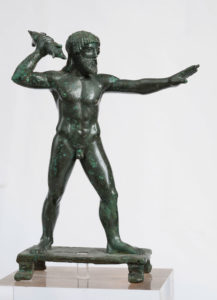[3] Σεμέλης δὲ Ζεὺς ἐρασθεὶς Ἥρας κρύφα συνευνάζεται. ἡ δὲ ἐξαπατηθεῖσα ὑπὸ Ἥρας, κατανεύσαντος αὐτῇ Διὸς πᾶν τὸ αἰτηθὲν ποιήσειν, αἰτεῖται τοιοῦτον αὐτὸν ἐλθεῖν οἷος ἦλθε μνηστευόμενος Ἥραν. Ζεὺς δὲ μὴ δυνάμενος ἀνανεῦσαι παραγίνεται εἰς τὸν θάλαμον αὐτῆς ἐφ᾽ ἅρματος ἀστραπαῖς ὁμοῦ καὶ βρονταῖς, καὶ κεραυνὸν ἵησιν. Σεμέλης δὲ διὰ τὸν φόβον ἐκλιπούσης, ἑξαμηνιαῖον τὸ βρέφος ἐξαμβλωθὲν ἐκ τοῦ πυρὸς ἁρπάσας ἐνέρραψε τῷ μηρῷ. ἀποθανούσης δὲ Σεμέλης, αἱ λοιπαὶ Κάδμου θυγατέρες διήνεγκαν λόγον, συνηυνῆσθαι θνητῷ τινι Σεμέλην καὶ καταψεύσασθαι Διός, καὶ ὅτι διὰ τοῦτο ἐκεραυνώθη.
- Map
- Pre Reading
- Post Reading
- Culture Essay
Watch the Ancient Greek Review video on Participles in Greek – Participles video.
Read an explanation how Participles work.
Practice exercises on participles.
Compare the wedding of Cadmus and Harmonia as described in Part A of “Semele and Ino” with the relationship between Zeus and Semele in Part B. Take a sheet of paper and list all the words or phrases that characterize Cadmus and Harmonia’s wedding with Semele and Zeus’ liaison. Pay special attention to who initiates which actions and whether the verbs used are active, middle, or passive. To what extent do gender or divine status play a role in shaping the outcome of each story?
N/A
